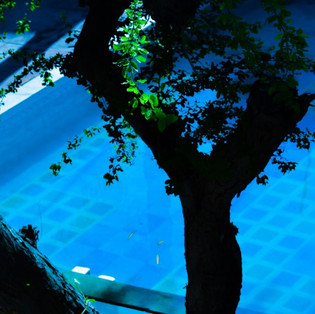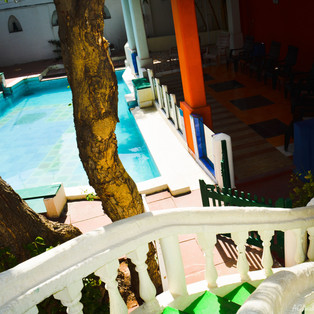Read the Day 1 recap here
Date: 5.4.2015
The stay, Hoka tree and fear
Siting outside with my coffee and cookies, at The Hoka Island Villa (*now it has undergone a make-over and called The Palms Beach Resort and one can't help but notice the compromised charm), life takes on a different meaning next morning. The colourful ambience of the open-air restaurant of this cosy villa with basic amenities and food (mostly of continental variety and as good as you can get in Diu) makes me temporarily believe that we are here to enjoy, probably better off not asking too many questions.
The staffs are cordial and cooperative. They may take some time to understand your request or concern, but they are making it up with me by showing their willingness to understand. That counts for me.
Erstwhile Hoka Island Villa
This is a reasonably good choice of stay if you are in company or visiting Diu as a solo backpacker. I booked this place months ago and now I find it almost full. The rooms are quite small, interior unflattering, with balcony being the saving grace. But they made it in a way that one ends up spending most of the idyllic evening outside near the small swimming pool or savouring the good music and food in Cat's Eye View (the restaurant) when the sea breeze also invites to take a 5-minute walk to Nagoa beach.
I stepped out last night and headed towards Nagoa for a stroll. However, the general vibe of the place is such that unless you are travelling in a group, you may not feel comfortable staying out late.
Placing order for breakfast, I look closely at the #Hokatree or #Hokkatree (doum plam), a type of branching palm brought by the Portuguese and found nowhere else in the country. I have already seen quite a few of these on my way back from the beach.
It is a native plant of Arabian peninsula and Egypt's Nile Valley where it was considered as sacred in ancient times and also the only Indian species of tree with African genus. An Egyptian archaeologist team found out 8 baskets of Hoka fruit (gingerbread fibre-rich fruit from doum palm), more than 3000 years old, while exploring the Ancient city of Thebes near Tutankhamun's tomb. The orange-red fruits are still well-preserved in 50 cm high fruit baskets.
Did King Tut (as Tutankhamen was popularly called) and many other Pharaohs suffer from hypertension? And that's why they were kept near the tomb, so that healing transcends through the afterlife? Because Hoka fruits got lots of medicinal properties, arresting hypertension being one of the most significant benefits. In the book 'Medicine in the Days of the Pharaohs', it is mentioned that the tombs of Ptahhotep and Ankhmahor at Saqqara depict
persons suffering from hypertension with advanced Schistosomiasis. The paucity of research work in India around folk medicines naturally made from its rich ecosystem is disheartening.
Hoka Tree
I close my eyes. I see the child playing on the Jalandhar beach who knows no fear, yet.
No Goa, Nagoa!
Two green bee-eaters catch my attention as I sip my morning tea, standing on the attached balcony. They are scanning through the tree for insects. They consume any insects, preferably honeybees, and hence the name. There's perhaps no refreshing sight than birds to start your day with. And even though they are abundant in wooded areas, my interest on this species grew manifold since when I got to learn that this bird can presumably predict the probability of their nests getting spotted by humans. Till recent time it was believed that this ability to interpret an event/situation from another's perspective is an attribute that only primates exhibit.

I start with my unfinished sojourn of last night to uncannily-shaped #NagoaBeach, rose with a gentle gradient to a cliff, surrounded by Hoka tree. I see many families are enjoying a bath in the greenish-blue water while youths are enjoying water-sports. The Diu Tourism Department conducts para sailing, wind surfing, water scooter, speed boat and so on in calmer stretches like Nagoa and Ghoghla.
Nagoa beach is the incongruous spot in Diu, it's full with sillier vibes.
Nagoa Beach, Diu
What makes it more interesting is the international-standard 4.3 Km long cycling track, separated from the main traffic and connecting Malala junction to Nagoa beach. It was inaugurated in this Union Territory to promote environment-friendly commuting, again a first in India. Tourists and locals can use it alike and eventually it will connect the entire island through coastal cycle-track and green pathways.
There's a reserve forest nearby where occasionally leopards straying from Gir can be spotted. I hear so wistfully as I finish my average breakfast from a beach dhaba. Two days ago I drove from Sasan Gir to Diu (Distance: Approx 100 Km, Travelling time: A little over 2 hours) and even though I have had excellent wildlife spotting in Gir otherwise, leopards eluded and I continue to remain hungry for more.
Talking about hunger, Nagoa beach is also the lone spot around which very few basic eateries and premium restaurants I get to see. There are few resorts around Jalandhar stretch, but absolutely nothing in terms of grabbing something for a quick bite from the roadside. On the less-crowded side of Nagoa, I happen to spot one Eastern Reef Heron with a slightly hunched posture. He too is foraging on the sand for snail.

I suddenly feel hungry and make my way for a hearty meal at Chulawala Restaurant & Bar, which is associated with Krishna Beach Resort. This is a good place to venture in when you can't decide what to eat. It has usual Punjabi fare, seafood, Thai food and Chinese in offing.
Next, I want to lazily explore the nearby seashell museum, which apparently houses close to 3000 varieties of shells, but unfortunately I find it closed. Nobody's there to offer a reason. With a little sulk, I head back to the villa for some rest.
Winding course through the bylanes
At around 5 PM, I leave my room, take an auto and reach #Vanakbara fishing village in less than half an hour.

After wandering around the port for an hour amidst the hustle and strong smell of fish which everyone may not find welcoming , I get lost in some unknown bylanes, thinking about how Portuguese managed to dominate the Indian Ocean with utter supremacy and torturous repression for one and a half centuries! They made it possible by establishing a network of canon-fueled forts in the coastal region and also due to their relatively advanced knowledge of cartography (creation of geographical charts and maps). Tomorrow I am going to visit perhaps the most prominent fort of their establishment, the Diu Fort.
How maritime trade over the time has changed in front of this peaceful and pensive sea slowly sinks in me as the twilight and gets forgotten by the imminent night as I dine in Rasal Beach Resort's multi-cuisine restaurant, right in front of the Nagoa Beach, and head towards Hoka Villa to throw myself on bed, literally.
Continued... Day 3
PhotoStory Date: 5.4.2015
Place: Diu island, Union Territory of Daman and Diu
Words and Photograph: Amrita Ghosh


















Comments